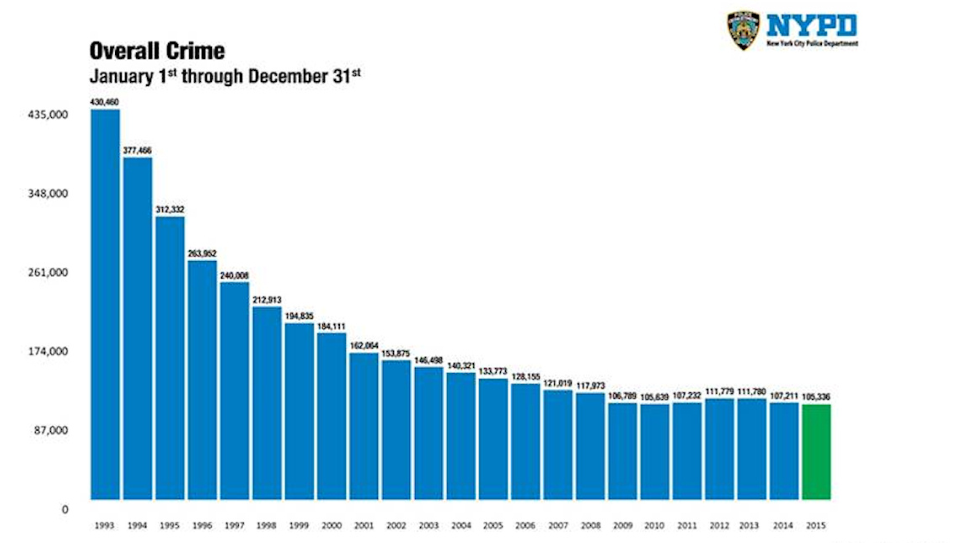According to Heraclitus, “The only thing that is constant is change.” Policing policies are constantly changing, with new laws and regulations being implemented and others being discarded. In New York City, the mayoral administrations have heavily determined the manner in which the police force deals with residents. Focusing on recent years, from Giuliani to the present, the transition of the approach to policing has shifted from what’s called “broken windows policing,” to a heavy implementation of stop and frisk, and then to a less confrontational method. Let’s take a look at how effective these tactics were.

During Rudy Giuliani’s administration, from 1994 to 2001, a complete shift in policing occurred. Instead of focusing on high rate crimes, and the notion that police could not control “street crimes,” the police department of NYC started targeting low level crimes. This was in the hopes that by controlling low rate crime, such as prostitution, drugs, and loitering, serious crime would be put to a stop as well.1 This theory of policing was based on a study done by Philip Zimbardo in 1969. He placed one car in an indigent area in New York City, and another in Palo Alto, a rich neighborhood. The  destruction and ransacking of the car in New York City took less than ten minutes to begin, while the one in California remained unscathed for more than a week. Then, after Zimbardo did a bit of damage to the car in Palo Alto, the car was ripped apart by passersby. The authors of the study concluded that all that is needed for havoc to break loose is a small amount of “disorder.” Public opinion shifted to the idea that “if police departments began addressing those problems, maybe the bigger crimes wouldn’t happen.”2 This method of policing became known as “quality of life policing,” or, more famously, “broken windows policing”. This approach was aggressive and had a zero-tolerance policy. Prostitutes were arrested on the daily, loiterers were chased away, and squeegee men disappeared from the streets. While crime rates were plummeting, there were adverse effects of this type of policing, including the dramatic increase of complaints of police misconduct and a general mistrust in the NYPD.3
destruction and ransacking of the car in New York City took less than ten minutes to begin, while the one in California remained unscathed for more than a week. Then, after Zimbardo did a bit of damage to the car in Palo Alto, the car was ripped apart by passersby. The authors of the study concluded that all that is needed for havoc to break loose is a small amount of “disorder.” Public opinion shifted to the idea that “if police departments began addressing those problems, maybe the bigger crimes wouldn’t happen.”2 This method of policing became known as “quality of life policing,” or, more famously, “broken windows policing”. This approach was aggressive and had a zero-tolerance policy. Prostitutes were arrested on the daily, loiterers were chased away, and squeegee men disappeared from the streets. While crime rates were plummeting, there were adverse effects of this type of policing, including the dramatic increase of complaints of police misconduct and a general mistrust in the NYPD.3
 In 2002, Michael Bloomberg succeeded Giuliani as mayor of New York City. Bloomberg tasked the police force with the tactic of Stop and Frisk. While this method of policing has faced serious scrutiny, Bloomberg focused on the numbers to tell the story of whether it was effective or not. Crime rates continued to drop, and it fell 32% over Bloomberg’s three terms.
In 2002, Michael Bloomberg succeeded Giuliani as mayor of New York City. Bloomberg tasked the police force with the tactic of Stop and Frisk. While this method of policing has faced serious scrutiny, Bloomberg focused on the numbers to tell the story of whether it was effective or not. Crime rates continued to drop, and it fell 32% over Bloomberg’s three terms.
“Through Dec. 15, there were 317 homicides reported in the city this year [2013]— 21.3% less than at the same time in 2012, when there were an already-low 419 killings for the year. It’s likely the lowest murder rate since the mid-1950s, when Mickey Mantle roamed center field in Yankee Stadium.”4
Bloomberg saw policing tactics as a means to an end. Lawyer Conti-cook challenged this idea stating that “crime is down, but the quality of life for my clients, for the people who interact with the police on a daily basis, is also down.”5 Without regard to Bloomberg’s opinion on the matter, stop and frisk was deemed unconstitutional in 2013. However, broken windows policing continued until the De Blasio administration.
Although each administration instituted changes in the style of policing, the De Blasio administration transitioned into a completely different approach. Amidst a spate of community residents killed during police interactions for seemingly trivial low-level crimes, Eric Garner’s death became a catalyst for change. De Blasio took measures to make sure that similar situations would not present themselves again. The NYPD moved from aggressive police protocol to a less confrontational stance. De Blasio instituted regulations that focused not only on reducing crime but also on developing trust between civilians and the police force as well as upping police accountability. There is more communication between neighborhoods and the police force to discuss issues preemptively, as well as a more racially diverse representation of policemen in indigent communities to reduce racial tensions. So far, these measures amongst others have proven to reduce complaints against the NYPD.6 After all, it seems that effective policing does not have to come at the price of mistrust and hostility towards the police force.
The general trend has shown that as policing method contribute to the falling crime rate, it also contributes to an increase of discontent of the police. Now, this trend seems to be breaking. It might seem like a novelty, but there might be an improvement in police-civilian interaction. It might be the new reality.



















